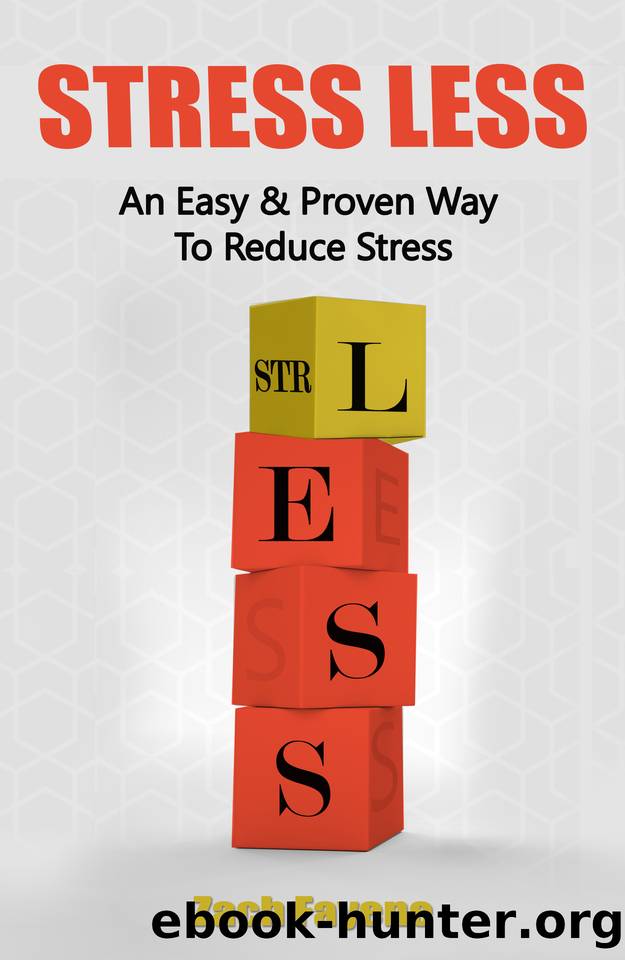Stress Less: An Easy and Proven Way to Cope & Reduce Stress by Fayena Dr. Izak (Zach)

Author:Fayena, Dr. Izak (Zach) [Fayena, Dr. Izak (Zach)]
Language: eng
Format: epub
Published: 2020-09-28T16:00:00+00:00
Chapter Five
Strategies For Dealing
With Stress
A byword for stress management strategies:
âWhat doesnât kill me, makes me stronger. â,
âIf we are doomed to suffer, at least enjoy it .â
In this section, I will review the stress management strategies in widespread use today. Some of them will be familiar to you, and some of the tools I present will no doubt be self-evident.
I urge you, dear readers, not to undervalue what you know and to persevere in regular practice. Constant training enables our brain to create new networks of neurons and eventually creates a change in our thinking patterns, replacing defective patterns with new and more effective ones.
Common Treatment Methods
The aim of this sub-chapter is to lay bare to you some common methods of dealing with emotional distress and suffering. Most of the described methods I have experimented with myself.
Naturally, everyone will choose the method that suits them, but it is important to ascertain that if you decide to be guided by a professional therapist just make sure that the therapist you choose is qualified, with the appropriate license and training. You should also seek recommendations from friends and acquaintances as to the effectiveness of their therapistâs treatment.
Remember, not every treatment is suitable for every problem or person, so we often find ourselves trying out a variety of methods until we can find the therapist and treatment method that best suits our needs.
At the core of all these methods is the patient, who is at the center. The role of the therapist is to reflect to the patient the reality as he sees it and to help him improve his level of functioning. The therapist should also provide the patient with tools to deal with what is troubling him or her.
An open interaction between therapist and patient is essential, as is the therapistâs capacity to listen and empathize, and the patientâs desire to implement the therapistâs recommendations.
1. Psychotherapy
Psychotherapy is derived from the world of psychological treatment. âPsychoâ in Greek means mind and âtherapyâ means âtreatment.â There are many subcategories within Psychotherapy, but it is worth discussing three of these approaches briefly, each of which utilizes different techniques and branches too diverse and detailed to be dealt with in the scope of this book :
The Analytical Approach â This approach focuses on a patientâs beliefs, values, and relationships with his or her environment as well as their basic perceptions.
The Psychotherapeutic-Dynamic Approach â This approach attempts to understand the repressed basis of mental distress, that is, the source of distress that occurred in the early years of the patientâs life. It is based on the psychoanalytic theory first formulated by Sigmund Freud. This approach is usually effective when it comes to a problem that is generalized and unfocused, such as a vague feeling of emptiness. In such a case, treatment aims at deepening patient understanding and suggesting ways of solving problems through an understanding of complex mental processes.
The Cognitive Behavioral Approach (CBT) â This approach is considered to be the most popular technique in use in recent years.
Download
This site does not store any files on its server. We only index and link to content provided by other sites. Please contact the content providers to delete copyright contents if any and email us, we'll remove relevant links or contents immediately.
What Happened to You? by Oprah Winfrey(1701)
Four Thousand Weeks by Oliver Burkeman(1687)
Karma by Sadhguru(1537)
This Changes Everything by Unknown(1447)
You Are a Badass: How to Stop Doubting Your Greatness and Start Living an Awesome Life by Jen Sincero(1103)
Don't Sweat the Small Stuff...and It's All Small Stuff by Richard Carlson(1042)
Infinite Circle by Bernie Glassman(994)
How to Do the Work by Dr. Nicole LePera(940)
Let's Talk About Hard Things by Anna Sale(927)
Real Strength: Build Your Resilience and Bounce Back From Anything by Psychologies Magazine(905)
Declutter Your Mind: A step by step guide to learn to control your thoughts, stop worrying, relieve anxiety and eliminate panic attacks and negative thinking by Mia Chandler(900)
The 4-Hour Workweek by Timothy Ferris(889)
Who Moved My Cheese? by Spencer Johnson(868)
The Path of Greatness--The Game of Life and How to Play It and Other Essential Works by Florence Scovel Shinn(868)
Be Your Best Self by Mike Bayer(840)
Breakup Bootcamp by Amy Chan(839)
Curative Magic by Rachel Patterson(819)
The Self Compassion Workbook: Practical Exercises to Approach Your Thoughts, Emotions, and Actions with Kindness by Johnson LCSW Joy(802)
Advice for Working Moms (HBR Working Parents Series) by unknow(802)
